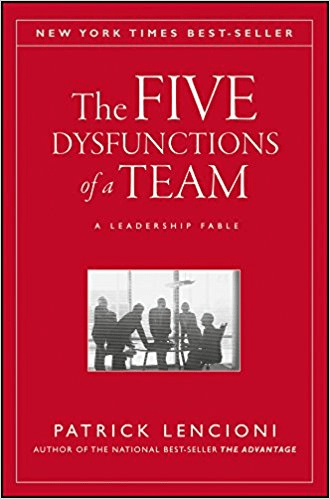A great book that highlights the problems encountered in running a team. It is a fictional story that shows how to turn things around and get buy in from team members and ultimately prevent and reduce problems from arising.

Although the story is fictional for demonstration purposes it is actually fairly engaging and highlights situations that are completely relatable. It of course tells a story that emphasises the 5 dysfunctions the book is about:
- Absence of Trust
Team members are unable to show their weaknesses and be vulnerable in front of others. If they cannot admit mistakes, speak openly or ask for help.
2. Fear Of Conflict
Without trust people develop fear of conflict. Team members are incapable of engaging in debates or openly voicing opinions. The team avoids conflicts which involve speaking up against bad decisions thus leading to inferior results.
3. Lack of Commitment
People do not reach a real consensus on decisions leading to reduced commitment. This results in reduce energy and ambiguous directions
4. Avoidance of Accountability
Lack of Commitment results in team members not assigning responsibilities or holding each other accountable. If they don’t buy into a decision they won’t follow up on making others do it.
5. Inattention to Results
Without accountability they put their own needs ahead of team goals. They look for personal recognition, career development etc… rather than making sure the team achieves it’s overall goals. This leads to the team losing sight of what it needs to do and the company achieving poorer results.
Addressing the dysfunctions
step 1. Acknowledge there are dysfunctions!
The leaders of the company need to lead by example and set the tone for the whole team. So they need to show their vulnerabilities, encourage debate and conflict, set clear responsibilities, timelines and standards and have a clear outcome the team is working for. They need to prioritise the success of the team above their own personal targets and help others achieve more at personal sacrifice.
It is important to note that a team doesn’t necessarily have to completely agree on everything as long as they all get heard and feel that their input has been considered. The team should not avoid conflict but instead embrace them.
Diagnosis
These questions are key to gauge the level of dysfunction within the team:
- Do team members openly and readily disclose their opinions?
- Are team meetings compelling and productive?
- Does the team come to decisions quickly and avoid getting bogged down in complete consensus?
- Do team members confront one another about their shortcomings?
- Do team members sacrifice their own interests for the good of the team?
Strategies to Overcome them
- Absence of Trust
- Time together
- ’Calling’ people on behaviour traits that demonstrate lack of trust
- Understand each other’s personal history
- Use personality profiling e.g. Myers-Briggs Type Index (MBTI)
- 360 degree feedback
2. Fear Of Conflict
- ’Calling’ people on behaviour traits that demonstrate fear of conflict
- Identify how we respond e.g. via Thomas-Kilmann conflict mode instrument
3. Lack of Commitment
- ’Calling’ people on behaviour traits that demonstrate lack of commitment
- Summarise decisions made in meetings
- Time-boxing decisions (any decision is better than no decision)
- Change course if wrong
- Clarify worst-case scenarios
- Low risk exposure therapy (c80% of the certainty of a decision comes within the first c20% of the data)
4. Avoidance of Accountability
- ’Calling’ people on behaviour traits that demonstrate avoidance of accountability
- Open publication of goals, standards and metrics
- Regular progress reviews
- Bonus for team not individual
5. Inattention to Results
- ’Calling’ people on behaviour traits that demonstrate inattention to results
- Public declaration of results
- Results based reviews
In the book the lead character takes the team on ‘away days’ where they learn to tackle problems head on. She starts by getting them to disclose their feelings about the company and their own actions. she reorganises the team involving one firing, one step down and one re-assignment as the team learns to trust each other and share their own shortcomings in their current roles. It’s hard to summarise the exact steps to take for such a process except to show clear fairness as a leader and a willingness to deal with problems for the good of the company. Every situation is different and it’s great to read the book to see this example of how the leader turns things around using all her skills.
Conclusion
No team is perfect and you want to work to achieve a safe ‘yes’ to all the above questions to create a blameless culture where the team is set on achieving it’s goals.
Creation of such a culture is a continuous effort and should be considered a journey not a destination.

